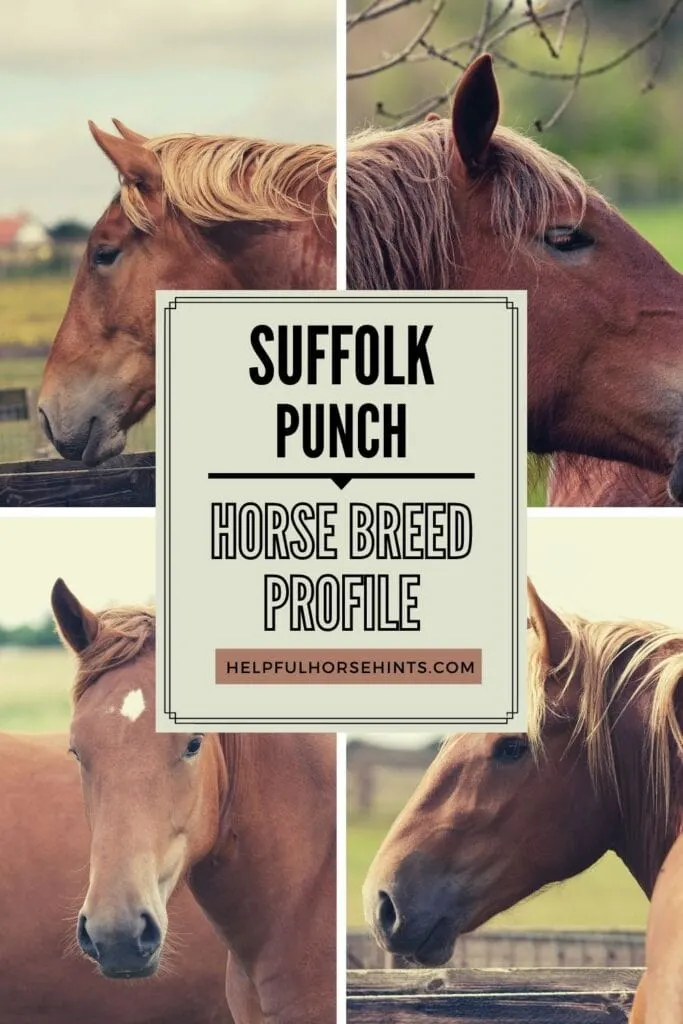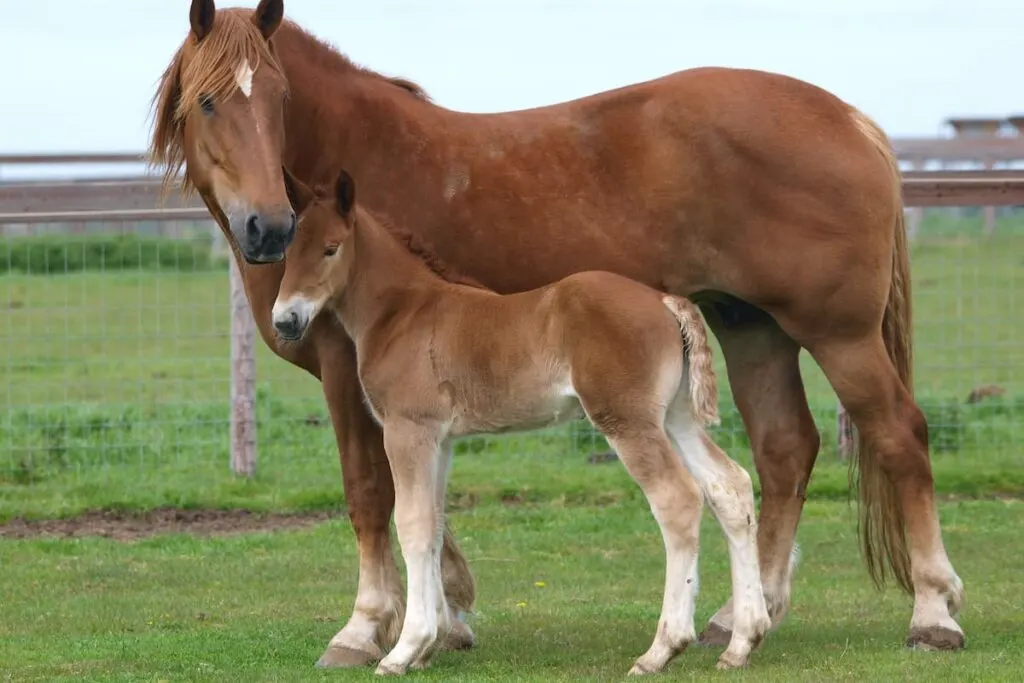When it comes to draft horses, Clydesdales and Percherons tend to get all the glory. But have you heard of the Suffolk Punch? Another member of the draft family, the Suffolk Punch is actually the smallest of the draft horses. Here’s everything you need to know to be a true expert on this rare breed.

Table of Contents
The Suffolk Punch Physical Appearance
Though still very powerful, the Suffolk Punch is the draft horse family’s smallest member. While other drafts can tower well above 17 hands, these horses are generally only 15.2 to 16.2 hands high (although some can reach 17 hands), much closer in height to a regular horse.
Even the taller Suffolk Punches often appear stout because they are so heavily built. (source) The extreme muscling rounds them out and gives them a smaller height to weight ratio, making them appear to be shorter than they really are.

Their draft horse roots, though, are best exemplified by how compact and stocky they are. Despite their smaller height, they still weigh in at 1,600 to 2,000 pounds and are known for their short yet thickly muscled necks, legs, and backs supported by dense bones.
They are also very symmetrical in build, creating a handsome appearance. They have strong, upright shoulders that give them strength rather than sudden sprinting speed.
They have short backs with high rib cages and a tail that is higher placed on their hindquarters than many other breeds. Their hips are widely set and smoothly muscled.

Unlike Clydesdales and Shires, the legs of the Suffolk Punch are consistently short-haired and don’t have the thick ‘feathers’ of other draft breeds. Bred for small farms, the Suffolk had to be versatile, and they didn’t need the protection of the feathers as much as heavier draft horses.
The Suffolk Punch has strong and powerfully built heads, with perky ears and a clean-cut jawline. Their hooves are strong and very rounded. The Suffolk Punch is known for strong feet, whether shod or barefoot, that don’t easily wear down or crack.
So distinctive is the appearance, too, that it actually influenced the common name for the horse. The breed is actually just called the Suffolk or the Suffolk Horse. However, their rounded appearance was so noticeably “punchy” that the nickname “Suffolk Punch” came about and it became common to refer to the breed by that name. (source)
Coat Colors
Unlike most other horse breeds, there is no variation in coat color. The Suffolk Punch is always chestnut with only the occasional white star or white hair on the legs. Though the chestnut may range in shade and lightness or darkness, the color itself never varies. No other color can even be registered in the Suffolk Stud Book.

It is such a remarkable breed characteristic that even the famous horse-focused author, Marguerite Henry (of Misty of Chincoteague fame) described the Suffolk Punch’s color in her Album of Horses as: “His color is bright chestnut–like a tongue of fire against black field furrows, against green corn blades, against yellow wheat, against blue horizons. Never is he any other color.”
Breed Personality and Temperament Traits
As is expected of draft horses, the Suffolk Punch is extremely even-tempered and easygoing. Suffolk horses are always willing to work; determined and renowned for their overall endurance. They have a drive to please and a great spirit.
The History of the Suffolk Punch
As the name would suggest, the Suffolk Punch originated in Suffolk, England, from that same medieval “great horse” lineage that is the origin of all other drafts breeds.
This old breed, however, is the purest of bloodline and has had the least amount of crossing with other breeds of all the drafts. In fact, they are considered one of the oldest draft horse breeds, with the foundation sire, Crisp’s Horse of Ufford, having been foaled in 1768.
Unlike other “great horse” descendants, the Suffolk Punch was not bred by lords and fighters in search of the next great war horse. Rather, they were developed by farmers looking for their own heavy horse; docile yet strong and suited to tilling fields and pulling carts more than serving as cavalry.
This makes them quite unique, as they can claim to be the only draft breed never bred for anything other than farm work. Although during the second world war they did pull some heavy artillery, they mostly remained out of combat.
Suffolk at the time was very rural and so the isolated farmers produced their own unique breed of working horse, one that went unmixed with other breeds for a long time.
The Suffolk Horse Society of Great Britain was organized in 1880, which is also the same year the breed was first imported to the United States.
Evolution of the Suffolk Punch
Once the Suffolk Punch became known outside of England, it was exported across Europe and then to America. However, when the Industrial Revolution began, the Suffolk found themselves in a bit of a limbo, because of machines that were now doing much of the work they were once prized for.
Though the Depression in the 1930s helped bolster the breed again as farmers went back to traditional methods, the industrial boom of the 1950s hit them hard. (source)
Even the Suffolk Horse Association went on hiatus for a few years. However, the 1960s saw the market for draft horses for show and exhibitions recover and the Suffolk Punch found a renewed interest from draft horse enthusiasts.
Though the Suffolk never really achieved the popularity of other draft breeds, they have maintained a strong fan base. Especially when it comes to farmers, the Suffolk is still a popular choice for a working horse. It is interesting that after hundreds of years, a breed has stayed so pure in its bloodline and true to the original purpose of their breeding.
And, although the breed’s status is considered “critical” on both the UK Rare Breeds Survival Trust and the American Livestock Breeds Conservancy, there has been a recent resurgence in numbers. (source)
Common Disciplines or Uses for Suffolk Punch Horses
The Suffolk horse was bred for farm work, and that is still where they shine. Thanks to their immense strength, powerful build and willing heart, they not only are very good at pulling, hauling and tilling, but they like to be busy and have a job.
The Suffolk’s aim to please has also made then excellent for pulling floats and carriages. Today, they are also often used for forestry work and in advertising.
Outside of draft work, Suffolks are great riding horses, especially for beginners. The hardest part of riding one, in fact, is getting one’s legs around their wide, barreled bodies! Once on board, they are pretty much bombproof and steady pleasure horses. They rarely spook and are very trainable and quiet, making them a good choice for new riders.

At the end of the day though, Suffolks are farm horses, through and through. Although machinery has taken over most of the farming industry, there still is work for horses, with the preferred farm horse being the Suffolk.
More than just the shorter cousin of the Clydesdale, the Suffolk horse has several unique qualities. Being bred for something other than warfare originally set them apart, but so does the fact that their pedigrees remain untouched for hundreds of years. Compact and strong, the Suffolk Punch is a truly enduring breed.

